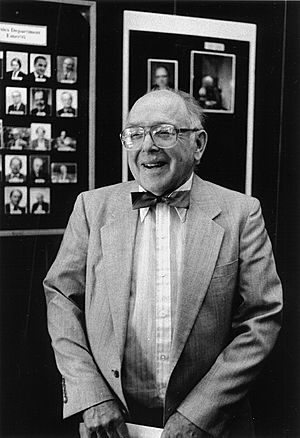Clifford Shull facts for kids
Quick facts for kids
Clifford Shull
|
|
|---|---|

Shull in 1994
|
|
| Born | September 23, 1915 |
| Died | March 31, 2001 (aged 85) |
| Nationality | American |
| Alma mater | Carnegie Institute of Technology New York University |
| Known for | Neutron scattering |
| Awards | Oliver E. Buckley Condensed Matter Prize (1956) Gregori Aminoff Prize (1993) Nobel Prize in Physics (1994) |
| Scientific career | |
| Fields | Physics |
| Doctoral advisor | Richard T. Cox |
Clifford Glenwood Shull (born September 23, 1915, in Pittsburgh, Pennsylvania – died March 31, 2001) was an American physicist. He won the Nobel Prize in Physics for his amazing work on a technique called neutron scattering. This method helps scientists "see" where atoms are inside different materials.
Contents
About Clifford Shull
Clifford Shull grew up in Pittsburgh. He went to Schenley High School. Later, he studied at the Carnegie Institute of Technology and New York University. He earned his PhD from New York University.
During World War II, he worked for The Texas Company. After the war, he joined the Clinton Laboratory, which is now Oak Ridge National Laboratory. In 1955, he started working at MIT. He retired from MIT in 1986. Clifford Shull passed away in 2001 when he was 85 years old.
Discovering Neutron Scattering
Clifford Shull received the Nobel Prize in Physics in 1994. He shared this award with a Canadian physicist named Bertram Brockhouse. They won for developing the neutron scattering technique. This method is like using tiny, invisible bullets (neutrons) to figure out what's inside a material.
How Neutron Scattering Works
Imagine you shine a beam of tiny particles called neutrons at a material. When these neutrons hit atoms inside the material, they bounce off. The way they bounce and change direction tells scientists where the atoms are located. It's like throwing a ball in a dark room and listening to where it hits to guess what furniture is there.
By understanding where atoms are and how they interact, scientists can learn a lot about a material. This knowledge helps them create better products. For example, it can lead to improved window glass, better computer chips, or even better microphones.
Early Research at Oak Ridge
Professor Shull began his important work in 1946. This was at what is now the Oak Ridge National Laboratory. After the war, scientists there wanted to find new ways to use the technology they had developed.
Clifford Shull worked with another scientist named Ernest O. Wollan. For nine years, they explored how to use neutrons from nuclear reactors. They wanted to study the atomic structure of different materials.
One of the most important problems Shull worked on was finding hydrogen atoms. Hydrogen atoms are in almost all living things and many other materials. Before neutron scattering, it was very hard to see them. But with neutrons, scientists could finally learn about materials that contain hydrogen.
As he improved the neutron scattering method, Professor Shull also studied the basic properties of neutrons themselves. He also started the first studies using neutrons to look at magnetic materials. Many people consider Professor Shull to be the "Father of Neutron Scattering" in the United States.
Awards and Recognition
Clifford Shull received many honors for his groundbreaking work.
- In 1956, he was given the Oliver E. Buckley Condensed Matter Prize by the American Physical Society.
- He was elected to the American Academy of Arts and Sciences in 1956.
- In 1975, he became a member of the National Academy of Sciences.
- The Royal Swedish Academy of Sciences awarded him the Gregori Aminoff Prize in 1993. This was for his work on using neutron diffraction to study atomic and magnetic structures.
- He received the Nobel Prize in Physics in 1994. He shared this top honor with Bertram Brockhouse.
- There are even some rocks in Antarctica named after him, called Shull Rocks!
Prizes Honoring Shull
Clifford Shull's legacy continues to inspire scientists. There are prizes and fellowships named after him:
- The The Clifford G. Shull Prize in Neutron Physics is awarded by the Neutron Scattering Society of America.
- The Clifford G. Shull Fellowship is offered by Oak Ridge National Laboratory.
See also
 In Spanish: Clifford Glenwood Shull para niños
In Spanish: Clifford Glenwood Shull para niños

